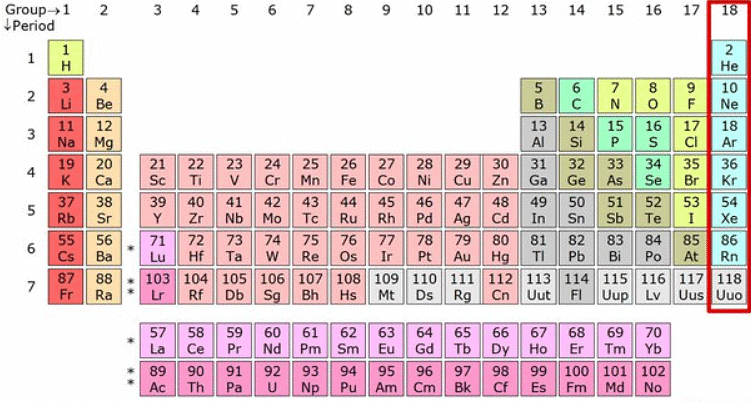Class 10 Exam > Class 10 Notes > Chemistry for GCSE/IGCSE > Noble Gases
Noble Gases | Chemistry for GCSE/IGCSE - Class 10 PDF Download
Noble Gases Properties & Electronic Configuration
The Noble Gases
- Noble gases belong to Group VIII (Group 0) and are classified as non-metals with exceptionally low melting and boiling points.
- They exist as monoatomic, colorless gases.
- All members of Group 0 possess complete outer electron shells, resulting in highly stable electronic configurations.
- Due to this stability, noble gases are chemically inert and unreactive.
- The electronic configurations of noble gases are as follows:
- Helium: 2
- Neon: 2,8
- Argon: 2,8,8
- Krypton: 2,8,18,8
- Xenon: 2,8,18,18,8
Noble gases are inert (unreactive) as they have a full outer shell of electrons so do not easily lose or gain electrons:

Question for Noble GasesTry yourself: Which group do noble gases belong to?View Solution
The document Noble Gases | Chemistry for GCSE/IGCSE - Class 10 is a part of the Class 10 Course Chemistry for GCSE/IGCSE.
All you need of Class 10 at this link: Class 10
|
72 videos|162 docs|61 tests
|
FAQs on Noble Gases - Chemistry for GCSE/IGCSE - Class 10
| 1. What are the properties of noble gases? |  |
Ans. Noble gases are colorless, odorless, and tasteless. They are non-reactive and have low boiling points. They are also known for their high ionization energy.
| 2. What is the electronic configuration of noble gases? |  |
Ans. The electronic configuration of noble gases is characterized by having a full outer shell of electrons, making them stable and unreactive. For example, the electronic configuration of helium is 1s2, neon is 2s2 2p6, and argon is 3s2 3p6.
| 3. How do noble gases behave under normal conditions? |  |
Ans. Noble gases are typically inert, meaning they do not readily form compounds with other elements. They are gases at room temperature and tend to be found in their pure form in the atmosphere.
| 4. Why are noble gases used in lighting applications? |  |
Ans. Noble gases are used in lighting applications because they can emit bright light when an electric current is passed through them. For example, neon gas is used in neon signs and argon gas is used in fluorescent lights.
| 5. What is the significance of noble gases in the periodic table? |  |
Ans. Noble gases are located in Group 18 of the periodic table and are also known as inert gases. They are important because they provide a stable reference point for understanding chemical reactivity and trends in the periodic table.
Related Searches















